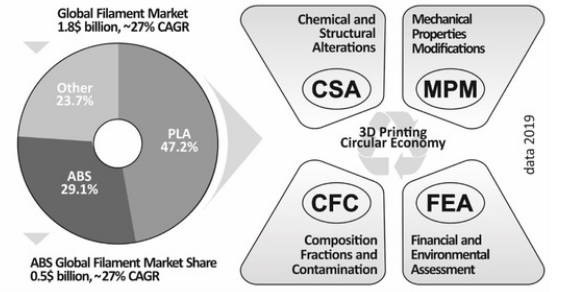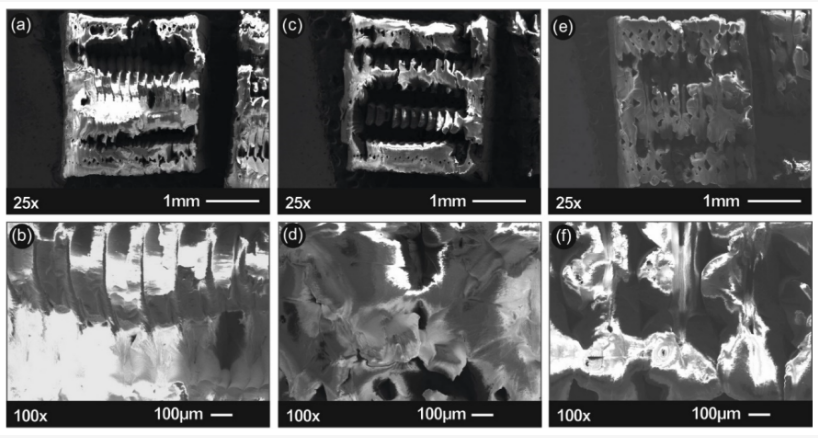Researchers from Greece experiment with sustainability in materials, detailing the findings of their study in the recently published ‘Sustainable Additive Manufacturing: Mechanical Response of Acrylonitrile-Butadiene-Styrene Over Multiple Recycling Processes.’
The study of materials science is enormous within the 3D printing user and research community today, ever-expanding as one innovation after another comes along—requiring specific software, hardware, and filaments, resins, or powders. Polymers, in particular, continue to be popular with users on all experience levels, mainly due to good operating temperatures, thermal properties, and corrosion resistance.
“Several studies have focused on the recyclability of polymer wastes by extruding them and then injection molding them into new parts or specimens to examine their mechanical, physical, and thermal properties,” stated the researchers. “Another novel strategy is to mix natural biodegradable material wastes, i.e., banana fibers or mussel shells with recycled polymer wastes, that can lead to the effective reduction of plastic waste.”
Research has also centered around recycling for industrial additive manufacturing technology, allowing for a variety of materials to be re-used. The following show good potential for recycling too: polyethylene terephthalate (PET), polyamide (PA) powders, aluminum oxide powders, and stainless-steel powders.
Researchers are also considering the feasibility of recycling and combining low-and high-density polyethylene (LDPE/HDPE). For FFF 3D printing, low-density polyethylene (LDPE), high-density polyethylene (HDPE), polyethylene (PE), polypropylene (PP), nylon, and other alternatives like recycled tires.
Much research has also centered around the recycling of and biodegradability of polylactic acid (PLA), one of the most popular 3D printing materials too, with the authors noting that while there has been increased focus on re-using materials, differences in quality have been noted regarding comparisons with virgin 3D printing filaments.

3D printing circular economy critical parameters and global filament market volume in 2019 (market volume data source: https://www.marketwatch.com/).
For this study, the researchers were mainly concerned with the effects on mechanical properties when printing with recycled acrylonitrile-butadiene-styrene (ABS) polymers. The powder was used to create a virgin filament for extrusion, fabricating test samples for the study which were then measured, evaluated, and tested. The leftover filament was recycled into pellets for extruding (using a 3devo shredder), with mechanical properties then tested further.
The researchers performed six series of recycling in all, with samples 3D printed on a Flashforge Inventor.
ABS samples were printed for the following tests:
- Tensile
- Compression
- Flexion
- Impact
- Micro-hardness

SEM images of the tensile fracture area of the representative specimens for 1st (a,b), 2nd (c,d) and 3rd (e,f) recycle course.

SEM images of the tensile fracture area of the representative specimens for 4th (g,h), 5th (i,j) and 6th (k,l) recycle course.
Overall, mechanical properties increased until the fifth recycling series.

Overall results on the mechanical properties of the virgin and recycled ABS in the 6 recycle courses studied.
“The increase in the mechanical properties of the specimens until the fifth cycle and the decrease in the sixth cycle can be justified due to the assumption that the first polymer thermal cycling courses cause re-alignment of the amorphous polymer chains, thus increasing the molecule interactions, stability and overall mechanical response of the polymer,” concluded the researchers. “After the fifth recycling course, chemical degradation takes place, breaking parts of the polymer chains, which is responsible for the decrease in the mobility of the ABS chains and increase in the Tg temperature of the polymer.
“The next steps based upon this work are to study the structuring, morphology and thermal properties changes of ABS filament throughout this recycling process.”
What do you think of this news? Let us know your thoughts! Join the discussion of this and other 3D printing topics at 3DPrintBoard.com.
[Source / Images: ‘Sustainable Additive Manufacturing: Mechanical Response of Acrylonitrile-Butadiene-Styrene Over Multiple Recycling Processes’]Subscribe to Our Email Newsletter
Stay up-to-date on all the latest news from the 3D printing industry and receive information and offers from third party vendors.
You May Also Like
3D Printing Financials: Fathom Struggles in Financial Quicksand During Critical Transition
Facing a year of key transitions and financial pressures, Fathom (Nasdaq: FTHM) has filed its annual report for 2023 with the U.S. Securities and Exchange Commission (SEC). The document outlines...
Latest Earnings Overview for Australian 3D Printing Firms Titomic and AML3D
Australian 3D printing manufacturing firms Titomic (ASX: TTT) and AML3D (ASX: AL3) reported their financial results for the period from July to December 2023, marking the first half of their...
3D Printing Webinar and Event Roundup: April 7, 2024
Webinars and events in the 3D printing industry are picking back up this week! Sea-Air-Space is coming to Maryland, and SAE International is sponsoring a 3D Systems webinar about 3D...
3D Printing Financials: Unpacking Farsoon and BLT’s 2023 Performance
In the Chinese 3D printing industry, two companies, Farsoon (SHA: 688433) and Bright Laser Technologies, or BLT (SHA: 688333), have recently unveiled their full-year earnings for 2023. Farsoon reported increases...
































